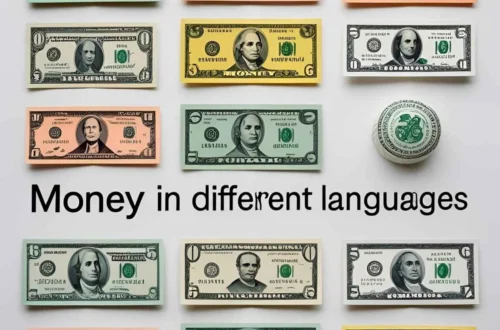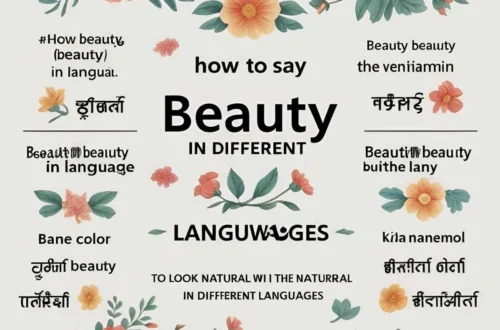Walking through a vibrant market in Marrakech, I overheard a vendor lightheartedly call a worn-out rug “qabīḥ,” sparking laughter among locals. The word for “ugly,” though often harsh, carries a universal human experience—our judgment of aesthetics shaped by culture and context.
Whether it’s a playful jab in a Tokyo alley or a poetic critique in a Parisian café, the term for “ugly” reveals how societies view beauty and imperfection. Let’s embark on a global journey to explore how people express “ugly” in different languages and what these words reveal about cultural perspectives.
Reference Table: “Ugly” in Different Languages
| Language | Word/Phrase | Cultural/Linguistic Insight |
|---|---|---|
| French | Laid | Used for physical or moral ugliness, often softened in tone. |
| Spanish | Feo | A direct term, used for appearances or behaviors, common in casual speech. |
| Italian | Brutto | Means “ugly” or “bad,” versatile in describing objects or situations. |
| German | Hässlich | A strong term for unattractiveness, used carefully due to its intensity. |
| Mandarin | Chǒu (丑) | Means “ugly” or “shameful,” tied to aesthetic and social judgment. |
| Hindi | Badsoorat | From “bad” (bad) and “soorat” (appearance), often used descriptively. |
| Japanese | Minikui (醜い) | Implies physical or moral ugliness, used sparingly for politeness. |
| Korean | Chireopda (추하다) | Suggests “unsightly,” used cautiously due to cultural sensitivity. |
| Arabic | Qabīḥ (قبيح) | Means “ugly” or “repulsive,” used across 20+ countries, often poetically. |
| Swahili | Mbaya | Means “bad” or “ugly,” used for appearances or poor quality. |
| Zulu | Mubi | A direct term for “ugly,” often used in lighthearted or serious contexts. |
| Yoruba | Ileru | Implies “unpleasant” or “ugly,” tied to aesthetic judgment in Nigeria. |
| Maori | Kino | Means “bad” or “ugly,” used for appearances or negative traits. |
| Hawaiian | ʻIno | Suggests “bad” or “ugly,” often tied to moral or physical flaws. |
| Cherokee | Uyo | A term for “ugly” or “unpleasant,” used in Native American communities. |
European Languages: Perceptions of Imperfection
European languages express “ugly” with terms that reflect cultural attitudes toward aesthetics. For instance, in French, “laid” is used for physical or moral ugliness, often softened with humor to avoid offense. Meanwhile, Spanish speakers say “feo,” a versatile term for unattractive appearances or behaviors, common in casual banter across Spain and Latin America. Additionally, Italian uses “brutto,” which can describe ugly objects, people, or situations, reflecting Italy’s expressive culture. In German, “hässlich” is a strong term, used cautiously due to its bluntness, aligning with Germany’s direct communication style. Thus, these words balance aesthetic judgment with cultural sensitivity, from poetic French to straightforward German.
Asian Languages: Subtle Judgments of Beauty
Asia’s diverse languages offer nuanced ways to say “ugly,” often tied to cultural values of harmony and politeness. For example, in Mandarin, “chǒu” (ugly) can also imply shame, reflecting China’s emphasis on social appearance. In Hindi, “badsoorat” combines “bad” and “appearance,” used descriptively in India’s vibrant markets. Similarly, Japanese uses “minikui,” a term for physical or moral ugliness, spoken sparingly to maintain politeness. In Korean, “chireopda” (unsightly) is used cautiously, aligning with South Korea’s focus on social harmony. Finally, Arabic’s “qabīḥ,” used in over 20 countries like Egypt and Saudi Arabia, carries a poetic tone, often softened in casual speech. These terms highlight Asia’s range, from direct judgments to culturally sensitive expressions.
African Languages: Community and Context in Judgment
In African languages, “ugly” often ties to community values and context. For instance, Swahili, spoken in over 20 countries like Kenya and Tanzania, uses “mbaya,” meaning “bad” or “ugly,” applied to appearances or poor quality in markets or conversations. In Zulu, “mubi” is a direct term in South Africa, used lightheartedly or seriously depending on context. Similarly, Yoruba’s “ileru” in Nigeria implies “unpleasant” or “ugly,” reflecting aesthetic judgment within communal settings. These terms, used across diverse African cultures, balance humor and honesty, often shared in social gatherings.
Indigenous & Island Languages: Simplicity in Aesthetic Judgment
Indigenous and island languages express “ugly” with simplicity and cultural depth. For example, Maori in New Zealand uses “kino,” meaning “bad” or “ugly,” applied to appearances or negative traits. In Hawaiian, “ʻino” suggests “bad” or “ugly,” often tied to moral or physical flaws, reflecting the aloha spirit’s focus on harmony. Similarly, Cherokee’s “uyo” is a concise term for “ugly” or “unpleasant,” used in Native American communities. In Samoan, terms like “leaga” (bad or ugly) reflect the Pacific’s communal approach, often used in group discussions. Across these cultures, from New Zealand to the Cherokee Nation, “ugly” emphasizes aesthetic and moral balance, tied to shared values.
Cultural Insights: The Evolution of Aesthetic Judgment
Words for “ugly” have evolved with cultural attitudes toward beauty. For instance, in ancient Greece, terms like “aischros” described physical or moral ugliness, influencing modern European languages. In Arabic, “qabīḥ” traces back to medieval poetry, where it critiqued aesthetics or character. Moreover, in African languages like Swahili, “mbaya” reflects trade-era exchanges, emphasizing quality. In Asia, terms like “chǒu” and “minikui” align with philosophies valuing harmony, often softening harsh judgments. These words carry histories of art, literature, and social norms, revealing how cultures define beauty and imperfection.
Proverbs and Sayings: Wisdom of Perception
- French: “La beauté est dans l’œil de celui qui regarde.” (Beauty is in the eye of the beholder.) – Emphasizes subjective perception.
- Hindi: “Roop se zyada dil saaf hona chahiye.” (The heart matters more than appearance.) – Prioritizes inner beauty.
- Swahili: “Mbaya kwa macho, mzuri kwa moyo.” (Ugly to the eyes, beautiful to the heart.) – Highlights inner worth.
- Japanese: “Minikui kao, yasashii kokoro.” (An ugly face, a kind heart.) – Values kindness over looks.
- Yoruba: “Ileru ni oju, ẹwa ni inu.” (Ugliness is on the face, beauty is within.) – Stresses inner qualities.
FAQs
Why do some words for “ugly” sound similar?
Shared linguistic roots (e.g., Indo-European languages) and cultural exchanges (e.g., Arabic’s influence on Swahili) create similarities.
What’s the oldest term for “ugly”?
Greek’s “aischros” (circa 5th century BCE) is among the earliest, used for physical or moral flaws, influencing modern terms.
How do cultures shape the term’s use?
Collectivist cultures (e.g., African, Indigenous) soften “ugly” with humor or context, while individualistic cultures (e.g., European) may use it more directly.
Conclusion
From “feo” in Spain to “mbaya” in Tanzania, the word for “ugly” weaves a global thread of human perception. Each term, whether the cautious “minikui” in Japanese or the warm “kino” in Maori, reflects cultural values while exploring our shared judgments of beauty. Consequently, these words remind us that perceptions of “ugly” are subjective, uniting all people in a universal dialogue about aesthetics. How do you say “ugly” in your language, and what does it reveal about your culture? Share your thoughts below—we’d love to hear your perspective!





